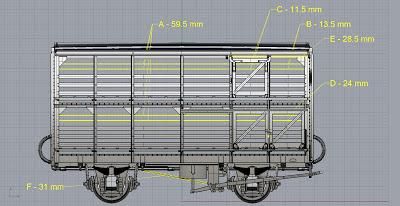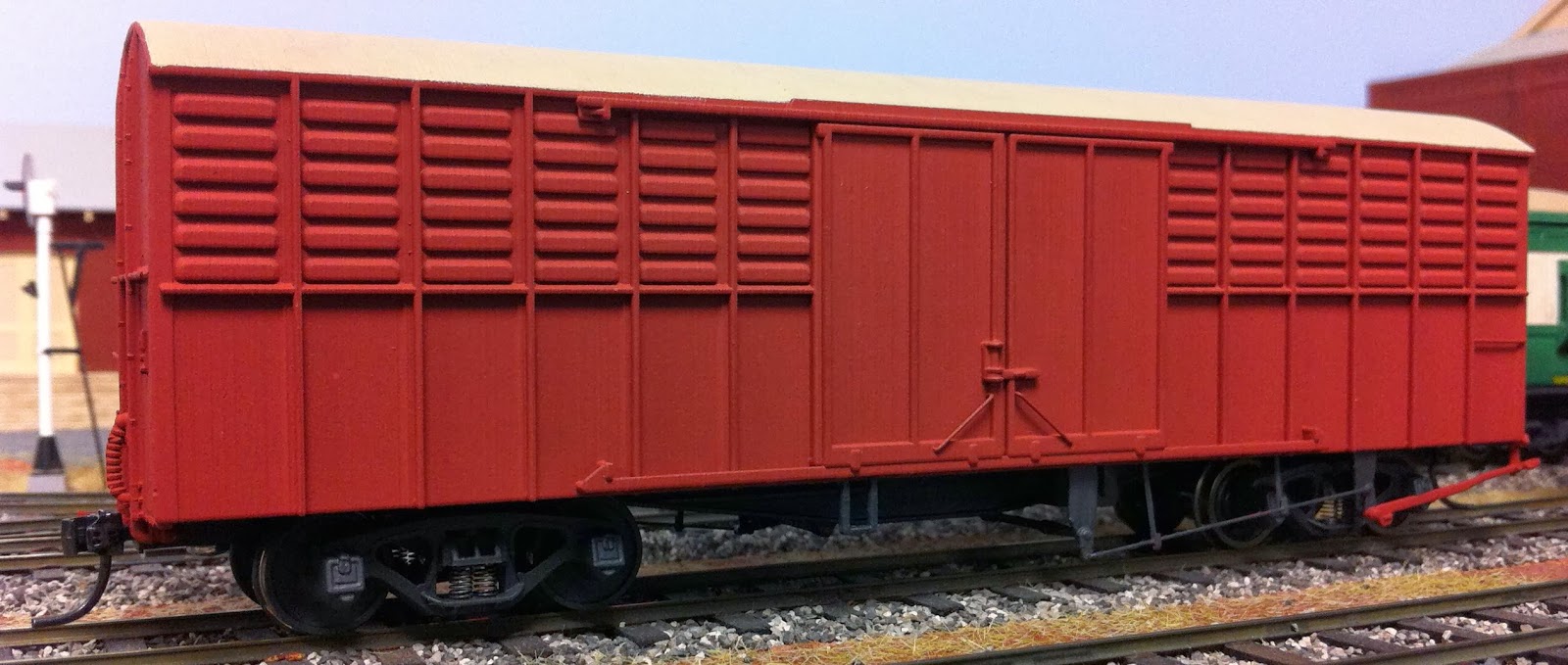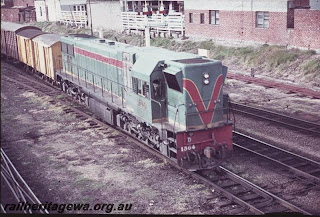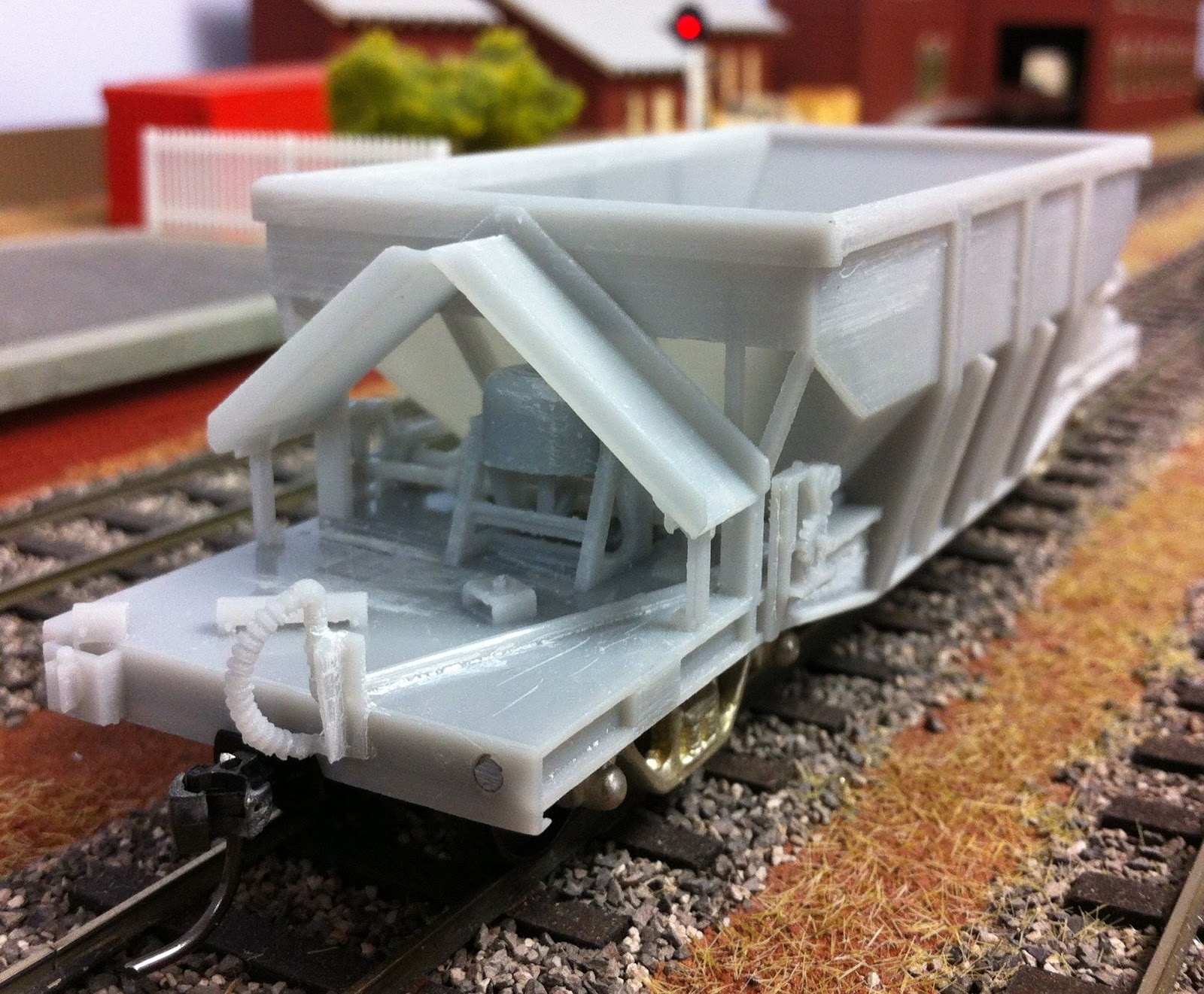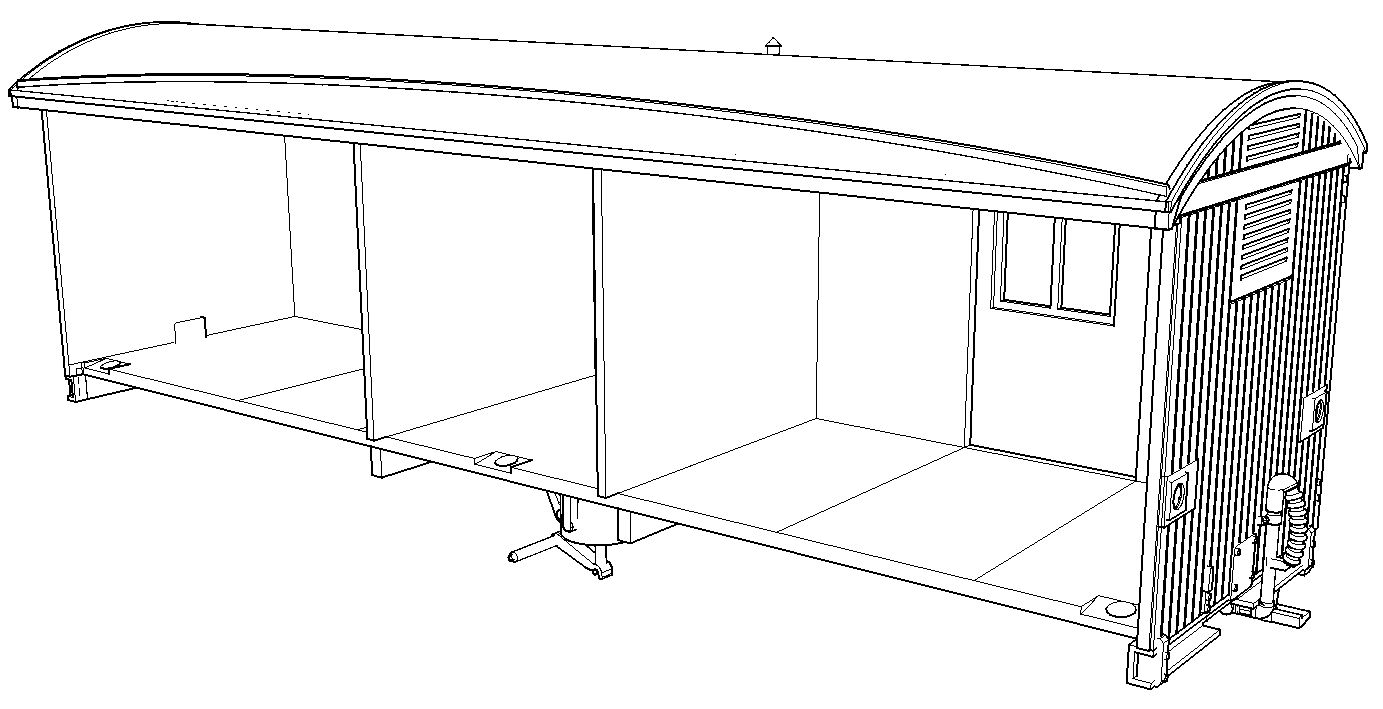This page refers to the "original" CXB design available in limited numbers prior to October 2013. For CXB's produced from October 2013 refer to the updated Construction Tips.
Removing Support Structures
Carefully remove the support structure from both parts of the wagon. It is suggested to use a sharp knife carefully cut the supports away from the roof, ends, and the underframe. Take particular care around the brake handle, brake hoses, W-irons, brake shoes and remainder of brake rigging, and the shunters steps.
Because of the fine ribbing on the brake hoses, the 3D printer's automatic software has generated many support points, which have merged into one. Carefully cut between the brake hose and the support structure, using repeated cuts with a sharp knife (e.g. Olfa snap-off blade type), to separate the support structure, then carefully trim the remnants from the hose.
Note that on the underside of the roof, alternating ribs extend a short distance beyond the edge of the roof to interlock the two parts when it is time for final assembly. Also note that on the middle floor of the smaller part, the floor ribs extend a short distance to interlock with the other part.
Because of the fine ribbing on the brake hoses, the 3D printer's automatic software has generated many support points, which have merged into one. Carefully cut between the brake hose and the support structure, using repeated cuts with a sharp knife (e.g. Olfa snap-off blade type), to separate the support structure, then carefully trim the remnants from the hose.
 |
| Interlocking Parts |
The support structure extends inside the upper and lower decks of the wagon to support the inside of the wagon sides. From the outside, cut through supports attached to the underside of the roof, and the underside of the middle floor. When you have cut as many of these supports as possible from the outside of the wagon, gently wiggling the supports structure (e.g. with needle nose pliers) from the open side, will break the remaining supports and allow pieces of the structure to be torn away. Be careful not to apply excessive force to avoid damaging the side planks and door areas.
Once the majority of the support structure has been removed, carefully go over both parts and cut away the small supports which typically extend from one part to another, for example, around the brake rigging and between the frame members of the underframe. An Exacto type hobby knife with a sharp pointed blade (Exacto #11 or similar) is quite useful for getting into the nooks and crannies.
Go around the surfaces of each part where they will join together, and smooth off any remnants of the fine supports, on the roof, ends, middle and lower floors, etc. A sanding stick or small file can be useful for this, but be careful not to damage the projecting parts which are designed to interlock. Also remove any remnants from the very ends of the projecting parts. When you think you have finished, test fit the two halves together. Interlock the roof ribs first, then gently bring the underside of the wagon together to see how it fits. As well as the interlocking projections at the middle floor level, there are four frame members in the underframe which have retangular pins which fit into oval holes in their opposite number (a variation on the square peg in the round hole concept). There are also two similar but smaller interlocking pins as part of the W-iron assembly at the end opposite the brake handle.
If the two halves don't close completely, dismantle again and check for and remove any tiny bumps from the support structure attachments.
Tapping Holes
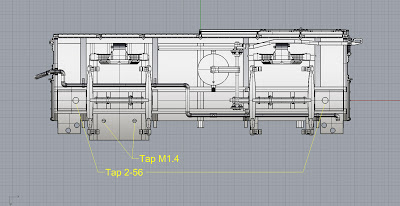 |
| Holes to be tapped - Left Side |
Tap the two holes in the W-iron assembly at the end opposite the brake handle with a M1.4 tap. These holes will secure the other half of the W-iron assembly after the wheelset has been inserted.
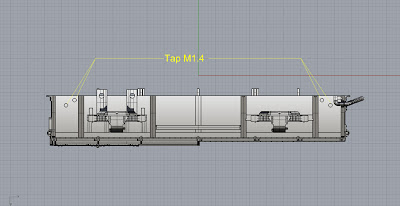 |
| Holes to be tapped - Right Side |
Note: Tapping the holes is preferable to using self-tapping screws which may fracture the material. Although fairly robust, the material is more brittle than styrene or polyurethane.
Bearings and Wheelsets
Gently clear out the bearing holes with a 2 mm drill bit in a pin vice, and also make sure there are no remants of supports in the recess around the bearing hole, otherwise the bearing may not go in all the way.
Press the bearings into the bearing hole, resting the axlebox on a small block of wood or similar to take the pressure to avoid bending the W-irons.
Insert one end of each axle into the bearing hole on the half with the brake shoes, and gently press the wheels into position, where they will be retained by the brake shoes pending final body assembly.
Body Assembly
As per the earlier test fit, interlock the roof sections first and gently close the gap at the underside of the wagon. Align the free ends of the axles with the bearings, which should allow the body halves to close together.
Insert M1.4 x 3 mm screws into the fixing holes at each end, to secure the two body halves together. Gently squeeze the sides of the wagon together to get a tight fit as you tighten the screws.
Insert 2 x M1.4 x 3 mm screws into the fixing holes in the W-iron assembly.
Check that the wheels roll freely without rubbing. Rubbing may occur if there are any tiny remnants of support attachments, particularly in the inside surfaces of the brake blocks.
In the long term, you have the option of gluing the body together, e.g. with superglue, or continuing to use the screw fixings. A half-way option is to just glue the roof area together, which would allow the join in the roof to be smoothed off, but would probably allow the underframe to be separated enough to change wheelsets, should that be necessary in the future.
Compensation Option
The W-iron assembly at the end opposite the brake handle, has a hidden "living hinge" which allows it to rock from side to side, to accommodate slightly uneven track. As supplied, the W-iron assembly is secured at each end to the inside of the solebars via four cylindrical connections. Cutting these connections, allows the W-iron assembly to rock and provide the compensation feature.
 |
| Cylindrical connections to be cut for compensation (4 each side) |
Adding Wire Detailing
- A - 59.5 mm, above timber side rails, 4 pieces per side
- B - 13.5 mm, above timber side rails, upper deck only, 2 pieces per side
- C - 12 mm, upper doors, 2 pieces per side
- D - 24 mm, lower doors, 2 pieces per side
- E - 28.5 mm, upper door top guide, 1 piece per side
- F - 31 mm not including 90 degree bend on one end, brake pull rod, 1 piece per wagon
The holes for the above have all been incorporated in the 3D-printed model, with a nominal diameter of 0.6 mm. If a wire does not go in easily, do not force it. Clean out the hole(s) with a 0.45 mm or 0.5 mm drill bit in a pin vice.
Also using 0.4 mm wire, form the handrails which are located vertically on the ends of the wagon, above the brake lever and shunter's step. The spacing between the holes is 6.5 mm.
Also using 0.4 mm wire, form the handrails which are located vertically on the ends of the wagon, above the brake lever and shunter's step. The spacing between the holes is 6.5 mm.
Weighting
With no additional weight, the completed wagon including wheels and couplers weighs around 38 grams. The "desirable" weight for a 4-wheel wagon is around 65-70 grams to ensure optimum operation including operation of Kadee couplers.
Addition of a Marbelup Models sheep load in Aluminide material adds approximately 24 grams, bringing the total weight up to around 62 grams.
If modelling an empty wagon, the weight can be increased by gluing lead shot or sheet lead between the various frame members of the underframe, where it would not be seen in normal operation. It would also be possible to slide thin metal (less than 1 mm thick) between the double floor layers, although this would preclude the view of "daylight" between the double floors.
Painting
Either enamel or acrylic hobby paints can be used to paint the finished model.
If desired, the interior of the wagon can be painted (airbrushed) prior to assembly. Experience to date suggests that this is probably not necessary as overspray from painting the outside tends to take away the "bare plastic" look on the inside surfaces.
Obviously, if a sheep load is to be included, it should be added after spray painting the wagon itself. Tamiya XF-78 Wooden Deck Tan is a reasonable colour for the sheep load.
Once the wagon is completely assembled, the join line on the roof can be filled and smoothed off. The join lines on the ends are virtually invisible as they are aligned with the angle iron end braces.
Back to Marbelup Models Home Page
